It’s January 7, 2014, and Buffalo NY is firmly in the grips of the Polar Vortex. It’s a silly name, and you think to yourself, “So what? It’s just another blizzard, this is Buffalo, it’s no big deal, I’m just going to put on my boots and go about my business.” NO YOU ARE NOT. This is some serious weather – the Thruway is closed across half the state, the mall is closed, businesses are closed, even bars are closed for the day. Right now, it’s not even snowing that hard in the city (the suburbs south of the city, however…tons of snow down there!) but it is so very windy that the visibility is almost zero. There are driving bans and the county is in a state of emergency. It is absolutely frigid, dangerously cold outside.
Needless to say, I have no intention of leaving the house today. It’s a perfect day to stay inside and do some baking! This morning I woke up, looked out the window and started baking my first ever batch of English muffins for a blizzard breakfast.
Long story short, we ate breakfast at noon on some very round, puffy rolls that only ever so vaguely resembled English muffins. Not exactly a success, but definitely not a failure, either. It’s the first step in a new mission for 2014 – perfect homemade English muffins.
I followed the English Muffin formula from The Bread Baker’s Apprentice.
English Muffins – adapted from The Bread Baker’s Apprentice
Ingredients
- 10 ounces bread flour
- .25 ounces granulated sugar
- .19 ounce (3/4 teaspoon) salt
- .14 ounce (1 and 1/4 teaspoon) instant yeast
- .5 ounce unsalted butter at room temperature
- 6 to 8 ounces milk or buttermilk, at room temperature

1. Stir together the flour, sugar, salt and yeast in a mixing bowl. Stir in (or mix on the lowest speed of your stand mixer) the butter and 6 ounces of the milk, until the dough forms a ball. It should be soft and pliable, not stiff.
2. Knead, or mix using a dough hook on medium speed, for 8 to 10 minutes. The dough should be tacky, but not sticky. It should pass the windowpane test and register 77 – 80 degrees. Lightly oil a bowl and transfer the dough, coating it with oil. Ferment at room temperature for 60 to 90 minutes, or until the dough doubles in size.
3. Wipe the counter with a damp cloth, and transfer the dough to the counter. Divide the dough into 6 equal pieces, each should be 3 ounces. Shape into mini boules. Place on prepared sheet pan (cover sheet pan with parchment paper, spray with non-stick spray oil and dust with cornmeal). The balls of dough should be about 3 inches apart. Cover with plastic wrap or a towel (I recommend plastic wrap if you have it, it does a better job of keeping the dough from drying out and forming a skin) and ferment for 60 to 90 minutes, until the dough nearly double and swell both up and out.
4. Heat a skillet (or flat griddle) to medium, and preheat the oven to 350.
5. Spray a little spray oil into the pan. Place the balls of dough on the pan – don’t crowd the pan. They should be about an inch apart. Cook for 5 to 8 minutes on each side. The dough should flatten in the pan and spread slightly, and then puff slightly. Each side should be deep golden brown – cook for as long as you can on each side, but flip them before they burn. When both sides are cooked and flat, move the muffins to the oven and finish baking for another 5 to 8 minutes to ensure the center is cooked through.
6. Cool for at least 30 minutes before slicing or serving. Full disclosure, we waited approximately 3 minutes before slicing open the first muffin.
So, um, clearly, these muffins did NOT flatten out in the pan. At first I was upset, but then we just laughed at them, because they look really silly. They taste just like a regular white bread, enriched roll, which is exactly what they are. Nothing great, nothing bad about them.
I’m not sure what went wrong – Evan thinks that it would have helped to flatten them out when I shaped them and we grilled them. I think that maybe the bench rise went a little bit too long, and that they over proofed just a bit, and that’s why they didn’t flatten out at all in the pan. We looked at other recipes, though, and some use a dough with a higher hydration, which is the classic way to get a more open crumb. There are a lot of other versions of this recipe, and I’m excited to try them, and see what it takes to get the perfect homemade English muffin. Or at least a decent homemade English muffin. Or even just something that looks more like an English muffin.
For today, though, we still had a delicious blizzard breakfast. As with most things in life, there’s nothing that a toaster, a little bit of cheese and a fried egg can’t fix.

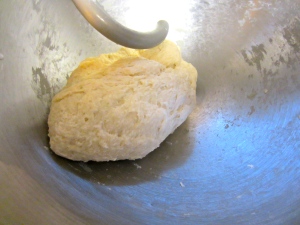
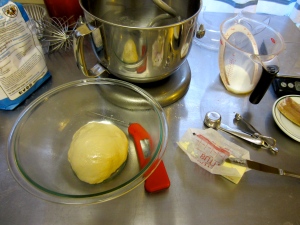
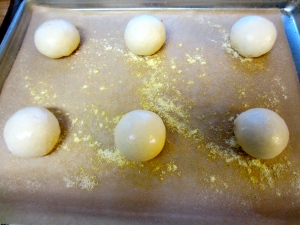
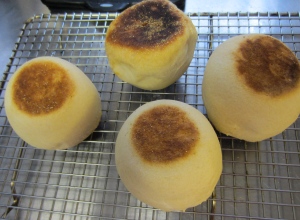
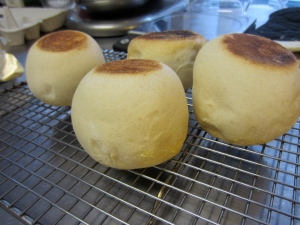
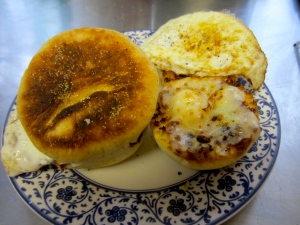
Was the UberYeast too effective?
I think so! Gotta keep an eye on that stuff…